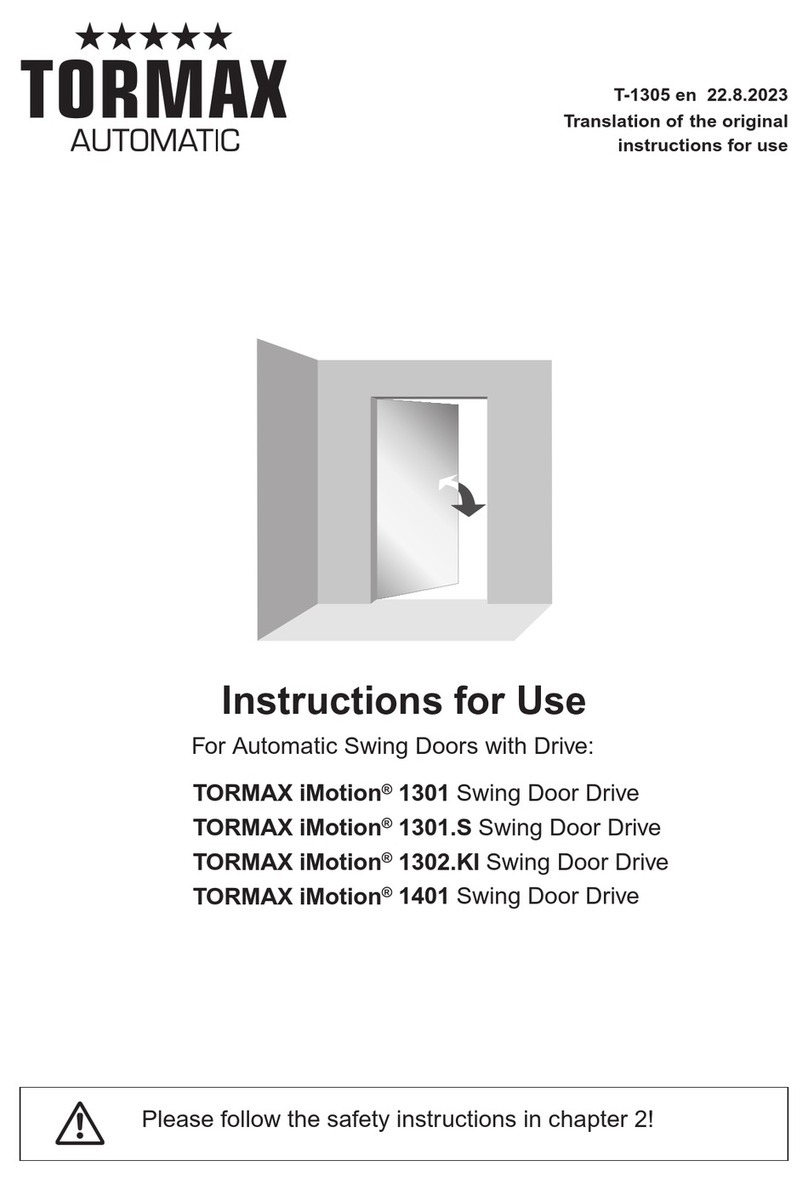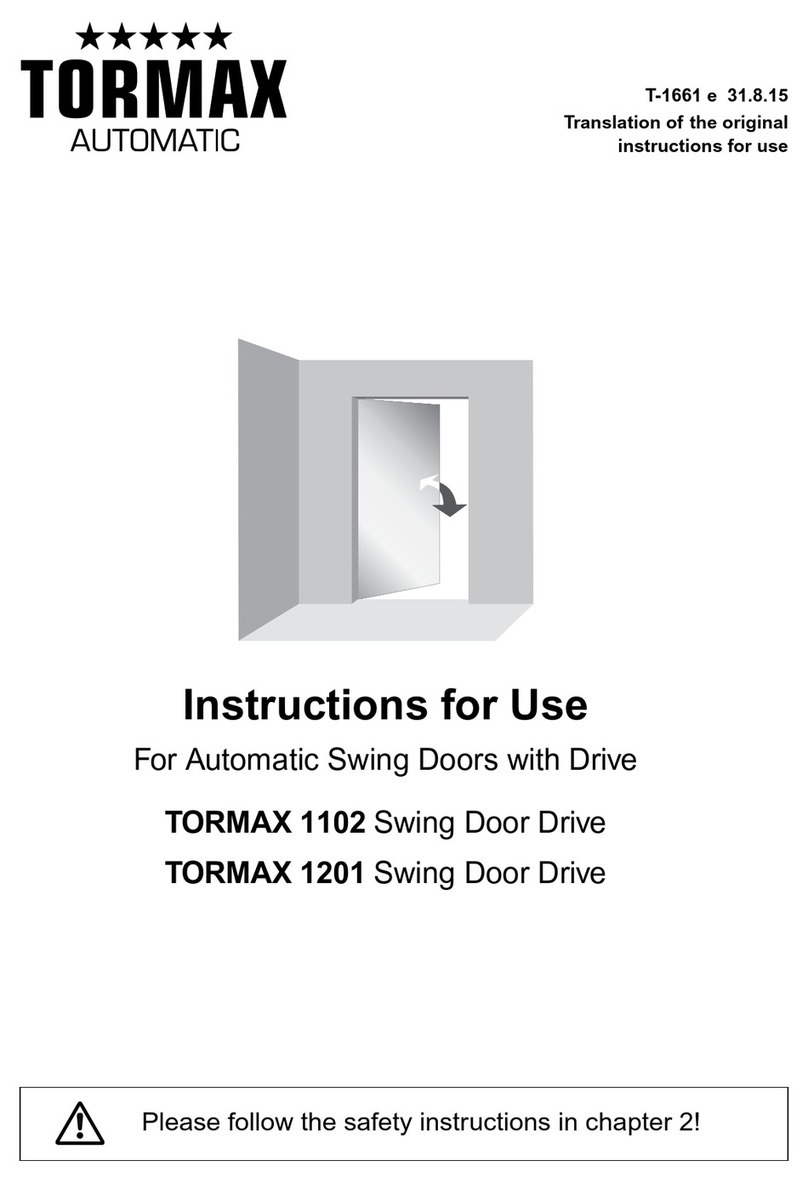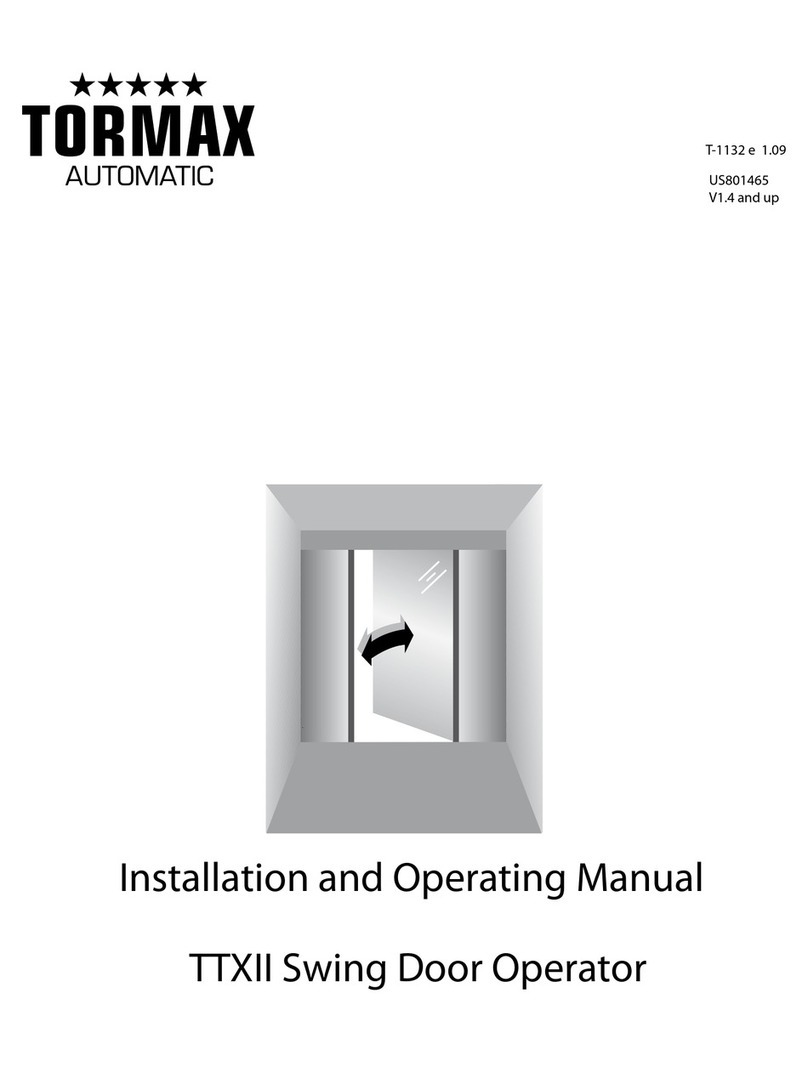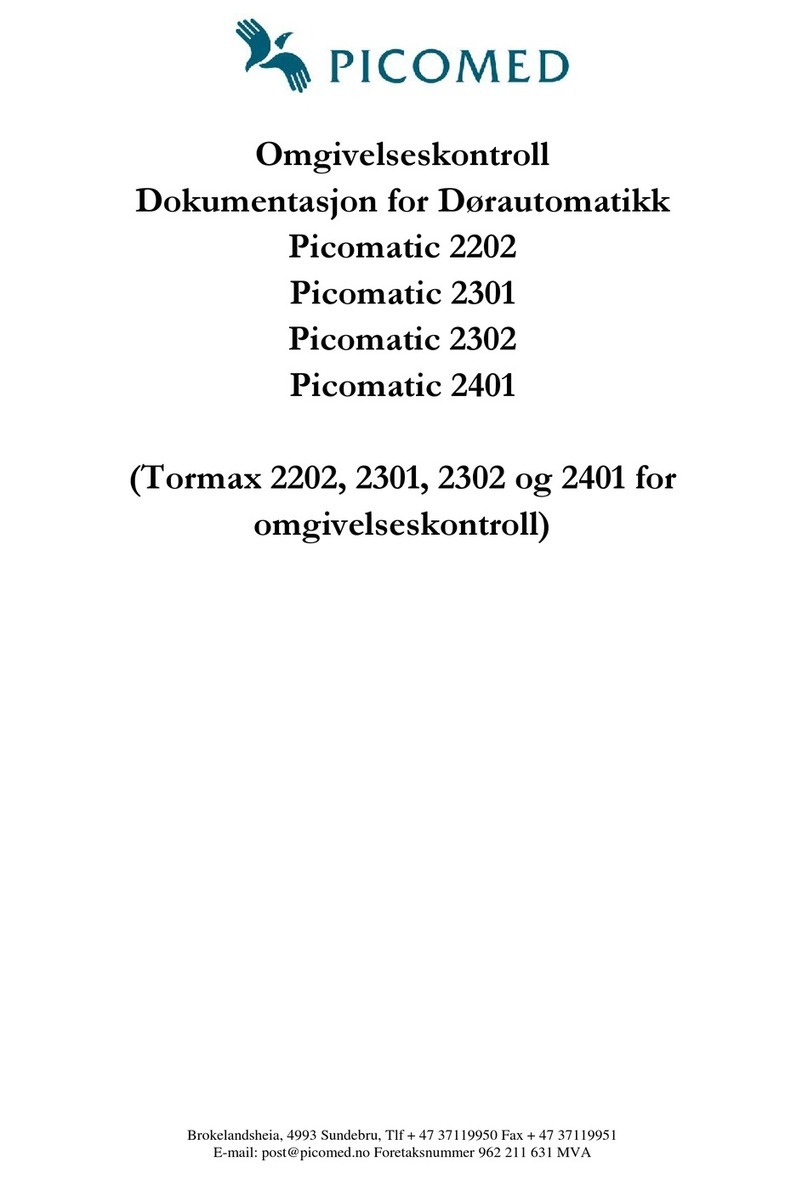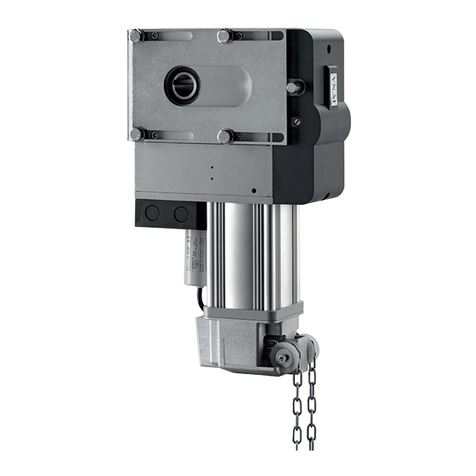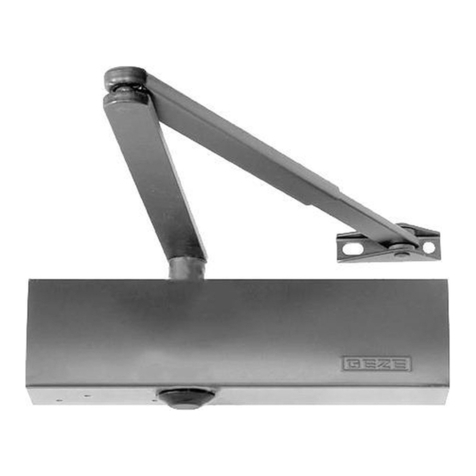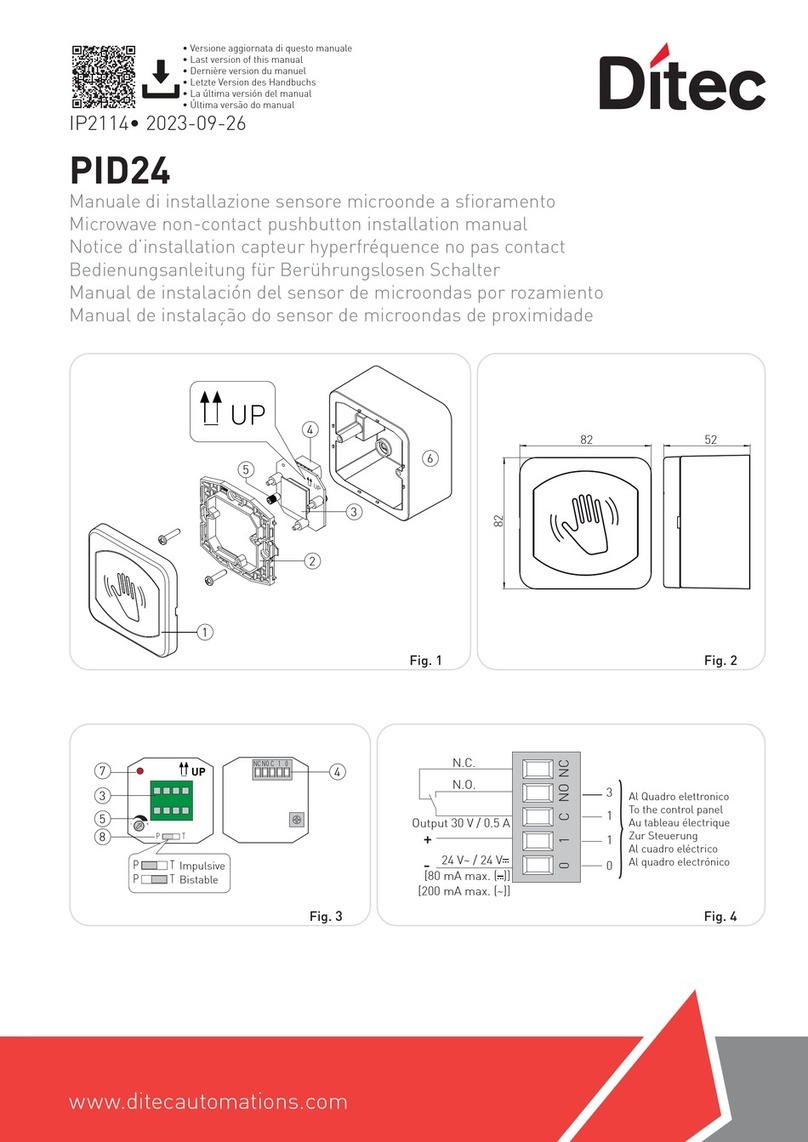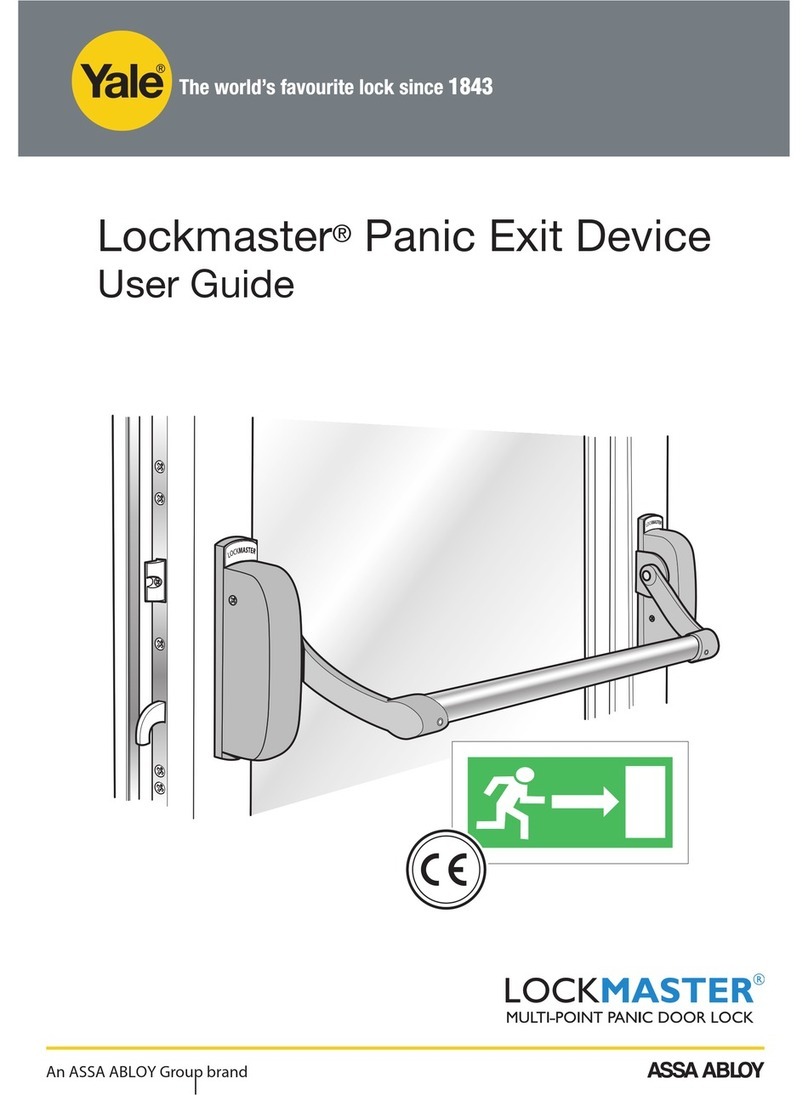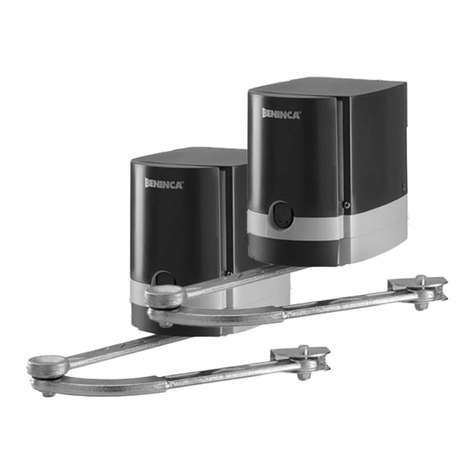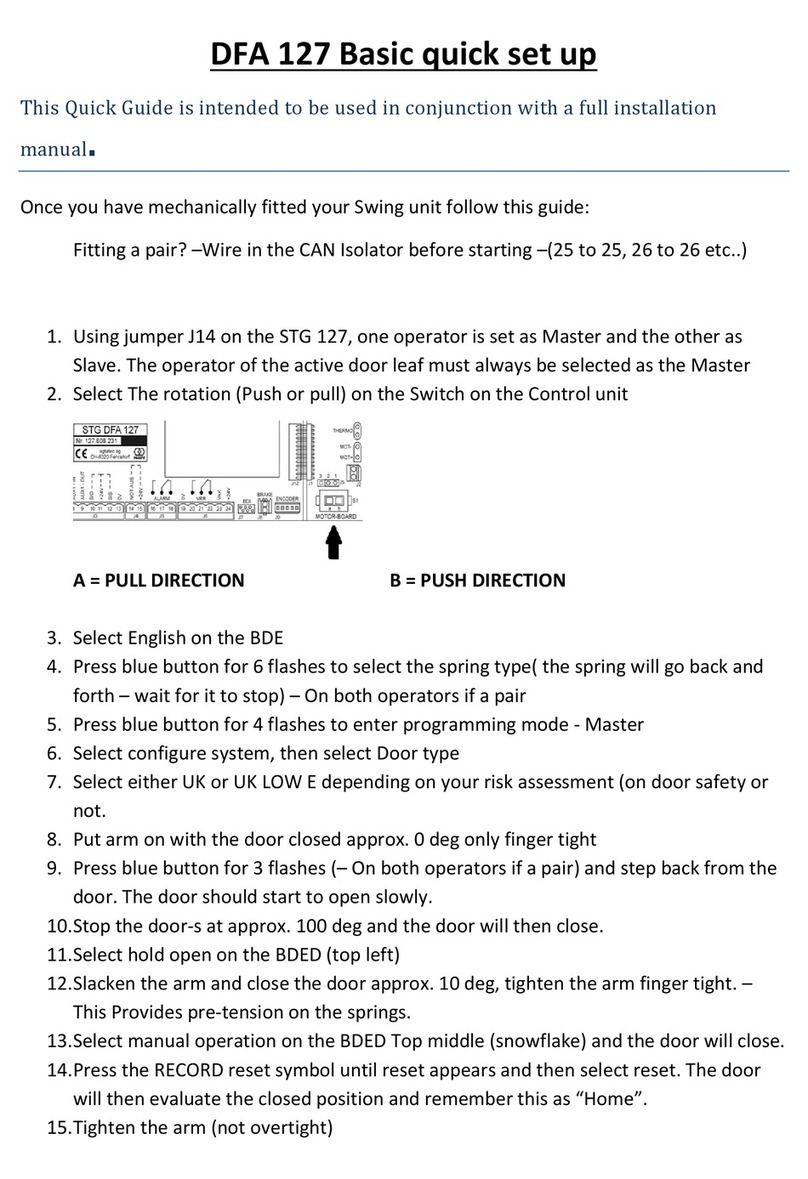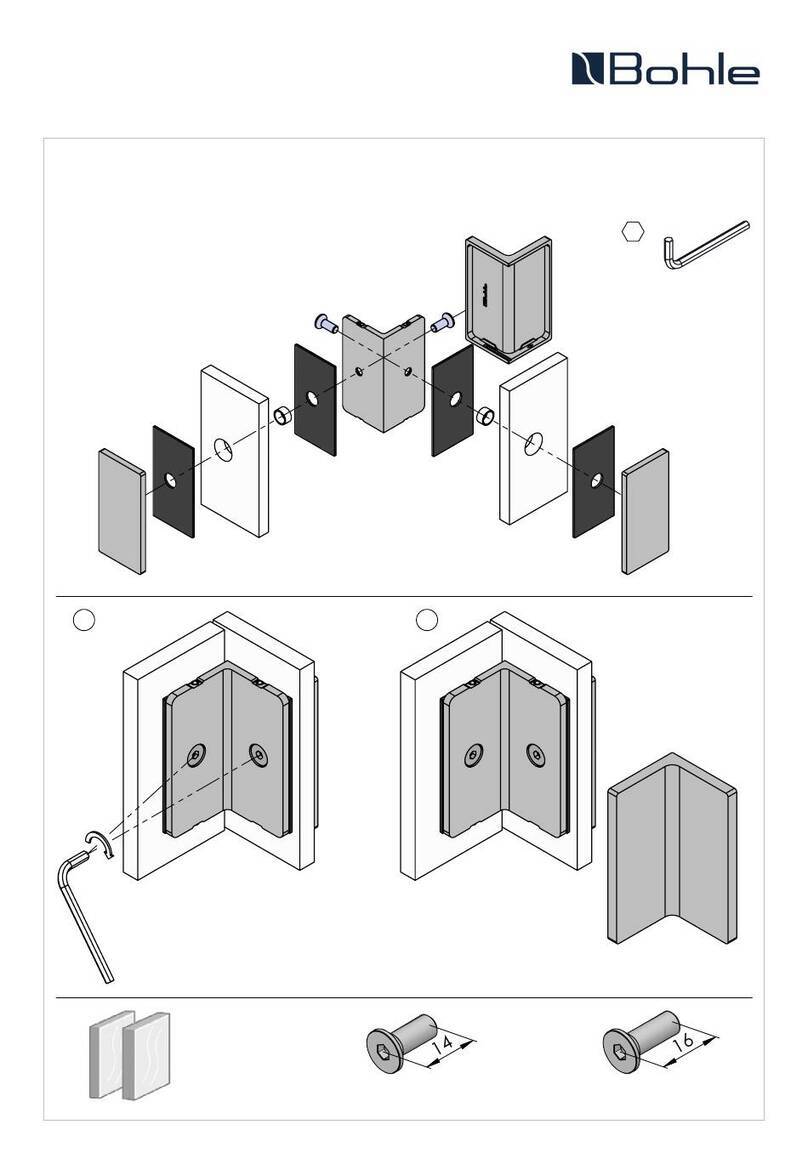Tormax iMotion 1301.FIRE User manual

T-1540 e 13.12.21
Translation of the original
instructions for use
Instructions for Use
For Automatic Swing Doors in hold-open systems
for fire doors with drive:
iMotion®1301.FIRE Swing Door Drive
iMotion®1401.FIRE Swing Door Drive
Please follow the safety instructions in chapter 2!

2Instructions for Use iMotion 1301.FIRE /1401.FIRE T-1540 e
First edition: 2.17, update: 4.21, 12.21
We reserve the right to make technical changes.
Contents
1 General Information 3
1.1 Target Groups 3
1.2 Storage and Forwarding of the Manual 3
1.3 Area of Application 3
1.4 Explanation of the Symbols 4
1.5 Technical Data 4
2 Safety 5
2.1 Responsibilities 5
2.2 Use for the Purpose Intended 5
2.3 Improper use 6
2.4 Pre-Conditions for the Operation of the System 6
2.5 Hazards and Risks 7
2.6 Checks 7
2.7 Decommissioning the System in the Event of a Fault 8
2.8 Disposal 8
3 System Overview 9
4 System Function 11
4.1 Operation in the Event of a Fire 11
4.2 Automatic Door Operation with Sensors 11
4.3 Semi-automatic Operation with “Push-and-Go” 12
4.4 Traffic Control 12
4.5 Automatic System Monitoring 12
4.6 Electrical Door Opener 12
4.7 Operation in the Event of a Power Failure 12
4.8 Operating Modes 12
5 Operation 14
5.1 Commissioning 14
5.2 Operation with the TORMAX User Interface 14
5.3 Operation with an Operating Mode Switch 15
5.4 Manual Release Button “Close Door” 15
5.5 Resetting the fire alarm 15
6 Procedure in the Event of a Fault 16
7 Maintenance 17
7.1 Cleaning 17
7.2 Testing the Fire Protection Function 17
7.3 Functional Check of the Swing Door System 18
7.4 Maintenance and Testing 18
8 Appendix 19
8.1 Fault Table 19
8.2 Check-List for Functional Checks 20
Declaration of Conformity 22

Instructions for Use iMotion 1301.FIRE /1401.FIRE T-1540 e 3
1 General Information
1.1 Target Groups
• Operator of the automatic swing door. The operator is the person responsible for the operation and
maintenance of the system.
• Persons instructed by the operator to carry out certain duties, for example the servicing and main-
tenance of the automatic swing door.
1.2 Storage and Forwarding of the Manual
• Store the instructions for use in the vicinity of the automatic door system.
• If the manual has become illegible due to constant usage, reorder the instructions.
For download and print out see also: www.tormax.com
• When the door system is transferred or resaled to a third party, pass the following documents to
the new owner:
– This instructions for use
– Documentation concerning modification and repair work
– Proof of the regular examinations System test book T-1543
1.3 Area of Application
Product name, door system: Automatic swing door and hold-open system for fire doors
Product name, door drive: iMotion 1301.FIRE Swing Door Drive
iMotion 1401.FIRE Swing Door Drive
The door drives are defined in more detail by a 4-figure number:
DIBT (German Building Technology Institute) technical approval: approval number Z-6.510-2569:
see document T-1570, download www.tormax.com
The identification plate with the serial number is
placed in the control box (1401) or on the drive
itself under the casing (1301, 1301.S).
Contact
Manufactured
Initial
Commissioning
System No.
Sliding Door
System TORMAX …………… .HERM
WT-299 e 3.18
DIN 18650-1:2010
N
e
x
t
S
e
r
v
i
c
e
2019
000/000/00
MM.YYYY
DD.MM.YYYY
Max Muster AG
Hauptstrasse 43 – 8049 Zürich
SERVICE: 043 827 33 55
Continuous numbering
Drive for swing door system
Increasing power
1 3 0 1
.FIRE = Drive for fire doors
Door system identification plate (example): located
on the side panel of the drive.

4Instructions for Use iMotion 1301.FIRE /1401.FIRE T-1540 e
1.4 Explanation of the Symbols
Warning (signal word)
Source of hazard (designates a possibly hazardous situation)
Possible consequences of non-observance
• Measures for averting danger.
Text which is highlighted in grey MUST be observed to ensure that the system operates perfectly.
Failure to observe these sections can cause damage to equipment.
Functions marked with this symbol are the factory setting. However, they can be reprogrammed
by a specialist.
Optional components which are not present in all systems.
1.5 Technical Data
Drive type Electromechanical swing door drive with AC permanent magnet
synchronous motor
Control system iMotion MCU32
Mains connection 1 x 230 V AC, 10 – 16 A /1 x 115 V AC, 15 – 20 A, 50 – 60 Hz
Power consumption iMotion 1301.FIRE 12 … 330 W
iMotion 1401.FIRE 6 … 250 W
Sensor supply 24 V DC + 0,5/ –1,5 V, max. 36 W / 1,5 A,
Fire protection module 24 VDC max. 7,2 W / 0,3 A
Protective class, drive iMotion 1301.FIRE IP 20
iMotion 1401.FIRE IP 68
Ambient temperature –20 °C to +50 °C
Noise emission level < 70 db (A)
Electromagnetic IEC 61000-6-2, IEC 61000-6-3
compatibility (EMV)
Service life Tested to 1’000’000 cycles
<

Instructions for Use iMotion 1301.FIRE /1401.FIRE T-1540 e 5
2 Safety
Warning
Important safety instructions
It is important to comply with these Instructions to ensure the safety of persons.
These Instructions must be kept in a safe place.
2.1 Responsibilities
For instructing the operator: A skilled person from a TORMAX sales partner
For operating the system: The operator or a person instructed by the operator
For maintenance: The operator or a person instructed by the operator or
company commissioned with proof of competence for
maintaining hold-open systems
For function control: A person instructed by the operator or a skilled person for
hold-open systems
For annual testing and approval: A skilled person authorised by the manufacturer
Skilled persons are persons who by virtue of their specialist training and experience possess sufficient
knowledge in the field of power-operated doors and are so conversant with the relevant health and
safety regulations, guide-lines and generally accepted engineering practice (particularly also DIN 14677
“Maintenance of electrically controlled hold-open systems for fire and smoke doors”) that they are able
to assess the condition of power-operated doors and hold-open systems with regard to their opera-
tional safety. Maintenance of electrical parts must be carried out by a trained electrician.
2.2 Use for the Purpose Intended
The product including the associated components is designed for the automation of horizontally mov-
ing swing doors for pedestrian access doors. The drive must only be installed in a dry environment
inside buildings.
• Assembly, installation, repair and maintenance work and the commissioning of the drive must only
be undertaken my qualified persons.
• The swing door drive may only be operated by properly trained persons who must also follow the
Instructions for Use.
• The door system may be used by persons with impaired physical, mental or sensory capabilities
provided that they are either under the supervision of the person responsible for their safety that the
latter has instructed them on the safe use of the system and its potential risks.
• Children must be supervised to ensure that they do not play close to the system and do not operate
any available operating controls.

6Instructions for Use iMotion 1301.FIRE /1401.FIRE T-1540 e
2.3 Improper use
The manufacturer will not accept any liability whatsoever for loss or damage caused by improper use,
failure to comply with the maintenance specification (see chapter 7) or unauthorised modification of
the system.
• Any conversion of the system (e.g. other user groups) is not permitted without a new risk assessment
(by a specialist) and the measures derived from it.
• Structural alterations in the danger area around the door system are prohibited without a new risk
assessment (by a specialist) and the measures derived from it.
• Modifications to the door system (e.g. different, heavier door leaves, different operating equipment
or sensor systems) may only be undertaken by a properly trained person who complies with the
technical limit values.
• Safety facilities (e.g. sensor technology, manual unlocking) must not be removed or disabled.
• User maintenance and cleaning of the system must not be undertaken by children.
Other improper uses (examples)
• Automatic doors with leaves moving vertically.
• Automatic doors with leaves moving in an inclined plane.
• Door systems incorporating a wicket door must not be automated.
• The drive must not be used as a drive for a wicket door.
• Automatic doors and gates located in transport equipment (e.g. motor vehicles or lifts)
• Use in abrasive and corrosive environments or in areas subject to the danger of explosions.
2.4 Pre-Conditions for the Operation of the System
The door system was designed, installed and checked for functionality and safety by skilled persons
prior to hand-over to the operator. The company responsible for the system’s installation instructed the
operator on the system’s use and maintenance as well dangers associated with the system operation.
The operator has confirmed this by his signature in the system test book T-1543.
The provisions imposed by law, health and safety and occupational health regulations for the avoidance
of accidents and the protection of the environment which are generally applicable in the country in
which the system is operated supplement the Instructions for Use.
• The staff responsible (see chapter 2.1) must have read and understood these Instructions before
commissioning or using the door system.
• Only use the system when it is in perfect working order. The operating conditions, inspection and
maintenance intervals stipulated by the manufacturer must be observed (section 7).
• Arrange to have any faults rectified immediately by a skilled person.
• Fire or smoke detectors must not be removed or rendered ineffective, e.g. by covering them.

Instructions for Use iMotion 1301.FIRE /1401.FIRE T-1540 e 7
2.5 Hazards and Risks
Depending on the system design and equipment, there is a residual risk of crushing, shearing and
collision with limited force in the movement area of the door leaf.
Warning
Danger through moving parts:
– in the area of all closing edges (especially hinge)
– in the region of the linkage lever
– when objects such as, for example, display shelves are erected in the direct proximity of
the moving part of the door leaf.
Warning
Hazards can arise due to deliberate damage, incorrect installation, defec-
tive sensors or sensors which are longer properly adjusted, sharp edges,
incorrectly mounted and defective casing or missing covers.
Danger for body and life, danger of injury
• Have system repaired by a qualified person
2.6 Checks
The regular checks and examinations set out in Chapter 7 must be carried out as instructed by the
manufacturer.
iMotion 1401.FIRE
iMotion 1301.FIRE
1
1
3
Opening
T1540_20
3
1
1
33
Closing
1
1
2
2

8Instructions for Use iMotion 1301.FIRE /1401.FIRE T-1540 e
2.7 Decommissioning the System in the Event of a Fault
If there is a fault the automatic swing door may only be taken out of service by a skilled person, the
operator or a person who is instructed to do so by the operator. This must be done on all occasions on
which the safety of persons could be compromised.
• Disconnect the door system from the power supply. All the poles are disconnected using a 3-pole
IEC-plug or another all-pole disconnection device (e.g. in the fuse box).
• If another power source (e.g. battery u) is available, it must be disconnected from the system by a
specialist.
• Hold-open systems must never be secured in the open position even if the system is not working
properly or in emergencies.
See section 6 and 8 for rectification of faults.
2.8 Disposal
This system must be properly dismantled at the end of its working life. Its disposal must comply with
national regulations. We recommend that you contact a skilled person disposal company.
Warning
Electric voltage
Risk of injury by electric shock
• Disconnect the mains power supply to the installation before dismantling.
Warning
Aggressive acids
Risk of injury if you dismantle the battery module.
• Dispose of batteries properly.
Warning
Flying around parts
The tensioned spring represents a hazard when dismantling the drive.
• Before opening the casing,
release the tension on the spring
up to the stop.
(iMotion 1301.FIRE: W = 0)
Warning
Broken glass
Risk of injury when dismantling the door leaves.
• Take care when transporting the door leaves.
T1305_2
T1305_1
W
W
iMotion 1301.FIRE iMotion 1401.FIRE

Instructions for Use iMotion 1301.FIRE /1401.FIRE T-1540 e 9
3 System Overview
T1540_4e
iMotion 1401.FIRE iMotion 1301.FIRE / 1401.FIRE
8c
8b
HK
HK
NK
NK GK
GK
5a
7b
6a
6b
1b
1a
4f
3a
3b
10b,c
4c 4d 4e 4a
5b 8d 4b
4c 4d
10a
8a 7a
7d 7c
3b
1a
1d
outside
3b
7a
5a 8b
HK
inside inside
iMotion 1301.FIRE
GK
1a,b
3a
1c
10b,c
4c, 4d, 4f
8a 8c
4c 4d 4e 4a
5b 8d 4b
7d
1401.FIRE
1 Drive a) Motor and spring unit
b) MCU32 control system with monitoring system, power limitation and
permanent diagnosis. Without current controlled door closing function.
c) Linkage / sliding lever (1301.FIRE)
d) Linkage pulling (1401.FIRE)
2Drive accessories £Mechanical door coordinator for double-leaf doors
£…
3 Door leaves a) Swing leaf * with main closing edge (HK) and secondary closing edge (NK)
b) £Finger protection * to enhance the safety of the secondary closing edge.
4Operating controls a) Manual release button
b) Manual reset button
c) £User interface with 6 operating modes and fault display
d) £Operating mode switch with 3 positions.
e) £Lock for the user interface
f) £Remote control of operating modes
5Internal activators a) With automatic activation b) With manual activation
£Radar with/without direction recognition * £Push button *
£IR motion detector * £Contact-free button *
£Contact mat * £…
6External activators a) With automatic activation b) With manual activation
£Radar with/without direction recognition * £Key switch
£IR motion detector * £Card reader *
£Contact mat * £Remote control *
£… £…
7Safety sensors a) £Presence sensor * safeguarding the swing area when closing
b) £Presence sensor * safeguarding the swing area when opening
c) £Presence sensor * safeguarding the opposing closing edge (GK)
d) £Presence sensor * safeguarding secondary closing edge (NK)
£…
8Emergency sys-
tems
a) Power switch / fuse * b) Fire detector *
c) £External fire alarm system * d) £Emergency-off switch *
9Output message £Bell / gong * £Light * £Door status
10 Lock a) Electrical door opener *
b) Door handle *
c) £Mechanical door lock *
£Depending on the system’s equipment
* Provided by the installation company.
The company installing the system must select and install suitable components in accordance with the prod-
uct standard EN16005 / DIN18650.

10 Instructions for Use iMotion 1301.FIRE /1401.FIRE T-1540 e
Block Diagram
All work on the mains power supply cable and the system's cabling must only be undertaken by an
authorised and properly trained person who must refer to all necessary documents.
Control unit
Motor
IEC plug
T1540_16e
230 VAC / 115 VAC
User interface
6 operating modes
Operating mode switch
3 operating modes
Manual release
button
Manual reset
button
Safety sensor
drive side
Opening activator
drive side
Safety sensor
opposite drive side
Opening activator
opposite drive side
or

Instructions for Use iMotion 1301.FIRE /1401.FIRE T-1540 e 11
4 System Function
After each occasion on which the fire door has opened you must ensure that it will close again prop-
erly. The area needed for the door to close must always be kept free from obstructions. This area must
be clearly marked by notices, markings on the floor or similar.
Fire doors must never be wedged open even if they are not in proper working order as they cannot
perform their function in this condition.
The operator of the door system is responsible for ensuring that the automatic swing door is freely
accessible at all times. The operator must particularly ensure that the swing area of the door leaves
is not obstructed by any objects.
T1540_12
4.1 Operation in the Event of a Fire
If the fire alarm is activated by the manual release button, a central fire alarm system or a fire detector
connected to the system, the fire alarm module incorporated into the door system immediately separates
the door from the power supply, thus causing the door to close in a controlled manner by means of the
spring. All the electronic safety devices on the drive are therefore inactivated at the same time. The
alarm status is indicated by the red LED on the reset button.
The closure of the fire door delays the spread of fire and smoke in the building for a period of time or
may even completely prevent the fire from spreading.
4.2 Automatic Door Operation with Sensors
When operating automatically (AUTOMATIC operating mode) the door is automatically opened from
both sides by sensors when a person approaches.
A key switch uor card reader unormally allows access from outside when the door is in operating
mode EXIT or OFF. The door unlocks, opens and closes again as soon as no further sensors are ac-
tivated after a hold-open time which is set separately.
The sensors for the door opening and the maintained opening of the door are arranged and adjusted
in such a way that the door opens promptly and remains open as long as a person is within the operat-
ing range of the door leaf. The door can close nevertheless but only after a time of approx. > 1 minute.
The reduced closing speed which is set by the installer and is adjusted in line with the door weight,
combined with a force of < 150 N prevents the impact of the moving leaves on a person from being too
severe. The obstruction is also detected by the control system and the door automatically reverses.
Safety sensors are necessary and depend on the design of the door system (distances, speeds,
forces applied by the door). When a person moves into the danger area, the door leaf stops or slows
down to a very low speed depending upon the settings performed by the fitter at the time of commis-
sioning.

12 Instructions for Use iMotion 1301.FIRE /1401.FIRE T-1540 e
4.3 Semi-automatic Operation with “Push-and-Go”
Instead of having sensors the door can be manually pushed open. After being detected by the control
system, the door opens automatically and closes again.
4.4 Traffic Control
Movement through the door can be allowed in only one direction if desired (operating mode EXIT) or
completely blocked (operating mode OFF). If there is a high level of pedestrian traffic or if the door is
to be used by infirm or frail persons, the door can be switched to operate in operating mode AUTO-
MATIC 2 with a longer hold-open time.
4.5 Automatic System Monitoring
The control system monitors the safety sensors by a cycle of active tests. The control system also
conducts continuous internal system tests. If a safety-related component should fail, the system auto-
matically switches into a safe condition. At the same time the fault number is displayed on the user
interface. You can find further information on this subject in section 6 “Procedure in the Event of a Fault”.
4.6 Electrical Door Opener
The system can be locked in the closed position by means of an electrical door opener.
4.7 Operation in the Event of a Power Failure
– Controlled closing using the integral spring.
– The door can be opened manually by means of the door handle (unlocking).
The door then closes again in a controlled manner using the integral spring.
4.8 Operating Modes
The automatic door system can be operated with the TORMAX user interface u(6 operating modes
and status display) or with an operating mode switch u(3 operating modes).
Operating Mode OFF
The internal and external sensors are disregarded. The door is mechanically held in the closed position
and locked using an electric door opener u. Access is only possible using the key switch or if the door
is manually unlocked using a key or the door handle is used to open the door manually.
<The door can still be used for 5 seconds after selecting operating mode OFF. The door then locks
at the end of this period as soon as it is closed. The transition is signalled on the user interface by the
flashing display of operating mode OFF.
Operating Mode AUTOMATIC 1
The operating mode AUTOMATIC 1 is normally used during the day. The door opens automatically
through the inside and outside sensors. The door can behave differently depending on the settings
programmed during commissioning:
“Push-and-Go”
If the door is manually pushed in the opening direction, it reacts as if to a command to open: it opens
automatically, waits for the hold-open time and then closes.

Instructions for Use iMotion 1301.FIRE /1401.FIRE T-1540 e 13
Systems with an Electrical Door Opener
The electric door opener unlocks on every valid opening impulse. The electrical door opener must be
manually activated with the door handle before it is possible to open the door with the “Push- and-Go”
system. In this operating mode the electrical door opener can also be permanently unlocked depending
on the setting programmed at the time of commissioning.
Operating Mode AUTOMATIC 2
Corresponds to operating mode AUTOMATIC 1 but a different motional sequence can be set during
commissioning (e.g. a slower opening movement, different open positions and a longer hold-open time).
Operating Mode EXIT
Operating mode EXIT is normally used for the period before the shop or office closes. The door will
only open automatically when activated by the internal sensor. When the door opens the external sen-
sor is also monitored for safety reasons. The open position is determined by the preceding selection
of the operating mode AUTOMATIC 1 or AUTOMATIC 2. The door can be locked automatically by the
electric door opener. The electric door opener can be permanently unlocked in this operating mode in
case of need.
Operating Mode OPEN
The door opens and remains open. The open position is determined by the preceding selection of the
operating mode AUTOMATIC 1 or AUTOMATIC 2. The door opens again on receiving the next open
impulse or when changing the operating mode to OFF and back again to OPEN.
Operating Mode Manual Operation
The door leaf can be freely moved. This operating mode can be used for cleaning the door leaf or for
temporarily shutting down the door. The system is reset after leaving this operating mode.
In this operating mode the electric door opener can also be permanently unlocked depending on the
setting programmed at the time of commissioning.
P

14 Instructions for Use iMotion 1301.FIRE /1401.FIRE T-1540 e
5 Operation
The automatic swing door may only be operated by a skilled person, the operator or a person in-
structed by the operator.
5.1 Commissioning
Before switching on the mains power supply:
• Unlock optional mechanical door locks.
• Check that the movement area of the door leaves is free from obstructions such as racks, plant
containers, umbrella stands etc.
• Switch on the mains power supply and select operating mode AUTOMATIC 1, for example.
The first movement after switching the power on for the first time is slow and H62 and H67 are
displayed. The control system is defining the closed position of the door leaf (H62) and is check-
ing the door leaf travel distance (H67).
The door is now ready for operation.
5.2 Operation with the TORMAX User Interface u
TORMAX User Interface Lock ufor User Interface
www.tormax.com
1
2
3
4
1
1
0
T1427_4
T1321_1e
OFF
AUTOMATIC 1
AUTOMATIC 2
OPEN
EXIT
Operating mode
symbols
Manual operation
Door electrically
locked
Selector key 2
Selector key 1
Unlocking of Operating Unit
The operating unit can be protected against unauthorized access by way of the lock uor the code lock.
• Unlock lock = position 0
or
• Enter code … / … / … using operating unit. The code can be determined by the engineer.
Example with code 3 / 3 / 3. Press upper selection button 3 times, then press the lower selection but-
ton 3 times and the upper selection button within 15 s . In case of entering wrong code: Wait at least
5 s . After successfully entering the code, the operating unit will be released within 60 s. The type of
operation can be adjusted. Access will be automatically blocked again for 60 s after the button has
been pressed for the last time.
Selection of Operating Modes
• Press selector keys 1 or 2 briefly. The corresponding operating mode symbol is illuminated.

Instructions for Use iMotion 1301.FIRE /1401.FIRE T-1540 e 15
Fault Display
E.g. H91 or E42 See section 8 for the meaning of the display.
• Reset by pressing the selector key 2 briefly.
Resetting the System
• Press the selector key 2 for at least 5 seconds.
The software is restarted. The control system then conducts a calibration run, checks the travel distance
and looks for the closed position. Displayed as H62 and H67.
5.3 Operation with an Operating Mode Switch u
Selection of Operating Modes
The switch position defines the operating mode.
OFF
AUTOMATIC 1
OPEN
T1540_11
Tür schliessen
!
T1540_2
Resetting the system
– Change the operating mode in the event of a fault
or
– Cut off power supply to the system for at least 5 seconds.
5.4 Manual Release Button “Close Door”
As required by various regulations, this button can be used to check that the door
will close properly as it would if the fire alarm were activated. This button does not
activate the fire alarm system itself!
Manual release button
After this button has been activated the door can still be opened manually at any time; the integral
spring will then close the door.
5.5 Resetting the fire alarm
Reset button for the fire alarm / activation
Red LED: fire alarm / activation
Green LED: system is ready for operation/ activation reset
Manual reset button
To reset the system to automatic operation press the reset button for 1 second. The red LED on the
reset button goes out and the door drive returns to its normal operating mode after the search run.
T1305_4

16 Instructions for Use iMotion 1301.FIRE /1401.FIRE T-1540 e
6 Procedure in the Event of a Fault
Faults are evident from abnormal door behaviour and/or as a fault display on the user interface. Fault
displays on the user interface take the form of a flashing “E” or “H” followed by two figures.
H = notification > the system can continue to be used.
E = fault > the system is stationary.
Some faults or notifications can be rectified by restarting the door drive with a software reset and/or
briefly disconnecting the system from the power supply.
Fault Display and Reset Using the TORMAX User Interface
See the table in section 8.1 for an overview of the fault displays.
Browse through the fault display using selector key 1 upwards
(to display several faults).
1. Reset the fault display, press selector key 2 (downwards) briefly.
2. Software reset: press the key for 5 seconds.
Reset of the Fault with the Operating Mode Switch
Software reset in the event of a fault: change the operating mode.
Reset of the Fault by Disconnecting the Power Supply
If the system does not have a battery unit, disconnect from the power supply for about 10 seconds.
If this does not reset the fault or if it re-occurs after a short time, you must arrange for the fault to be
rectified by a skilled person from your TORMAX dealer. In this case note the fault number and inform
the dealer. See the last page or the service tag on the system for the dealer’s address.
Resetting the fire alarm (red LED illuminated)
Press the reset button for at least 1 second:
green LED is illuminated
red LED goes out
T1305_5
!
T1540_2
rote LED
grüne LED
T1305_4

Instructions for Use iMotion 1301.FIRE /1401.FIRE T-1540 e 17
!
T1540_2
T1540_11
Tür schliessen
7 Maintenance
The system was tested and approved by a skilled person before initial commissioning. The manufac-
turer recommends that you conclude a service contract in order to maintain the value of your system
for as long as possible as well as to ensure the system operates reliably and safely for a long time.
Only genuine TORMAX spare part should be used. The manufacturer accepts no liability if you fail
to observe this requirement. Original spare parts and original accessories guarantee the safety of
use in accordance with norm EN 16005.
Warning
Possible risk of injury!
Entrapment of limbs can lead to serious injury.
• The drive must be disconnected from all power sources, including batteries during clean-
ing maintenance and replacement of parts.
7.1 Cleaning
• Clean casing parts, the user interface and door leaves with a damp cloth and a commercial cleaner.
7.2 Testing the Fire Protection Function
The operator must test at least once per month whether the door will close.
Press the red manual release button “Close door”. This triggers the emergency closure. The red LED
on the manual reset button indicates that the system has been activated. Once the door is fully closed
no further automatic activation of the opening movement of the door should be possible.
Successful completion of the test must be recorded in the system test book.
Manual release button Manual reset button

18 Instructions for Use iMotion 1301.FIRE /1401.FIRE T-1540 e
7.3 Functional Check of the Swing Door System
The operator must check the function and safety devices of the automatic swing door at least
every three months. This will ensure that faults or hazardous changes in the system are detected
at an early stage. See section 8.2 “Check-list for Functional Checks” for items to be checked.
You should arrange for any defects detected during the routine checks to be rectified immediately by
a TORMAX dealer (see the last page of this manual for the address).
Warning
Potential switching malfunction in the automatic swing door.
Potential hazards – injury caused by impact or crushing.
• Secure the area around the door while checking the door's functions.
7.4 Maintenance and Testing
Maintenance and testing should only be carried out by a trained skilled person following the manufac-
turer’s instructions.
Warning
Possible risk of injury!
Entrapment of limbs can lead to serious injury.
• The drive must be disconnected from all power sources, including batteries during main-
tenance and replacement of parts.
Maintenance Interval
The operator is obliged to have the hold-open system checked at least once a year for proper and
trouble-free interaction of all devices and to have it serviced.
Scope of the Maintenance Work
The content of the maintenance work is specified by the manufacturer in an inspection list.
System Test Book
The test findings are recorded after the test in the system test book. The operator must keep it in a safe
place.

Instructions for Use iMotion 1301.FIRE /1401.FIRE T-1540 e 19
8 Appendix
8.1 Fault Table
System Behaviour No. Cause Remedy/ Rectification
The door stops when
opening.
H91 Electronic obstacle recognition on
opening caused by persons, wind
pressure and ventilation.
Remove the obstruction.
Avoid drafts.
Door reverses when
closing.
H92 Electronic obstacle recognition on
closing caused by persons, wind
pressure and ventilation.
Remove the obstruction.
Avoid drafts.
The door stops repeat-
edly when opening.
H93 Electronic obstacle recognition on
opening in the same position by sta-
tionary obstacle.
Remove the obstruction.
The door stops repeat-
edly when closing.
H94 Electronic obstacle recognition on
closing in the same position by sta-
tionary obstacle.
Remove the obstruction.
Search run notified. H62
H67
Search run of the door after a reset or
after power recovery.
Allow the search run to travel its full
course.
Door remains closed. – Fire alarm or manual activation Press reset button for 1 second.
Door remains closed. – Operating mode for example OFF,
EXIT or P. The door is prevented from
moving by the lock.
E.g. select operating mode AUTO-
MATIC 1. Unlock the lock. Push the
door closed briefly.
Door remains open. – Operating mode for example OPEN or
P or door is blocked.
E.g. select operating mode AUTO-
MATIC 1. Remove the obstruction.
The door remains
closed.
E31 The safety facility in the opening direc-
tion is permanently active (>1 minute)
or defective.
Remove objects from within the
range of the sensor(s).
The door remains open E32 The safety facility in the closing direc-
tion is permanently active (>1 minute)
or defective.
Remove objects from within the
range of the sensor(s).
The door does not
open or does not close.
E33 The safety facility for the swing area is
permanently active (>1 minute) or de-
fective.
Remove objects from within the
range of the sensor(s).
The door does not
open or does not close.
E34 The stop safety facility is permanently
active (>1 minute) or defective.
Remove objects from within the
range of the sensor(s).
The door remains
open.
E41
E42
E43
Activator inside is active > 1 min.
Activator outside is active > 1 min.
Key switch is active > 1 min.
Get sensor adjusted by a skilled
person.
Reset the key switch.
The door stands still E5.. Anomaly in the travel distance.
Solid obstruction in the movement
area.
Remove firm obstacle in the trav-
elling range of the door.
Perform a software-reset.
The door stands still E61
E62
Power supply is overloaded or volt-
age too low.
Get the power supply and connec-
tions checked by a skilled person.
The door stands still E64
E65
Drive/control system is overheated. Wait for the automatic reset after
the door/control system has
cooled. Protect from direct
sunlight.
The door stands still. E..
E8..
Control system shut down for safety
reasons.
Perform a software-reset.
The door collides with
people.
– Safety device or setting inadequate. Shut down the system.
(see section 2.7).

20 Instructions for Use iMotion 1301.FIRE /1401.FIRE T-1540 e
8.2 Check-List for Functional Checks
Item To Be Checked Procedure Result
Fire Protection Function
T1540_11
Tür schliessen
“Close door”
• Press the release button The door immediately closes com-
pletely. Red LED on the reset but-
ton is illuminated.
!
T1540_2
Reset button
• Press the reset button (1 sec.)
Check every month!
The system reverts to normal op-
eration. The green LED is illumi-
nated.
Sensors
T1661_4
min. 1 m
• Walk through the door direct-
ly from the front and from dif-
ferent directions at normal
speed, starting both from the
inside and outside. Activation
(sensor field) at least 1 m in
front of the open main clos-
ing edge.
The door opens at the right time
and with sufficient speed so that
passage through the door Is not
hindered.
Safety Sensors
T1661_19
• Walk through the door direct-
ly from the front and from dif-
ferent directions at a slow
speed like an infirm person,
starting both from the inside
and outside.
The door opens and remains
open until you are completely
through the door.
Swing Leaf, Door Frame
T1540_10
• Check the glass door fillings,
door edges and rubber pro-
files for damage.
The door fillings have no sharp
edges and splintered glass.
The side parts and the door seals
are in place and undamaged.
Drive/Control box
T1540_14
• Check screws and cover
plate.
Screws and cover plate are firmly
mounted.
This manual suits for next models
1
Table of contents
Other Tormax Door Opening System manuals
Popular Door Opening System manuals by other brands
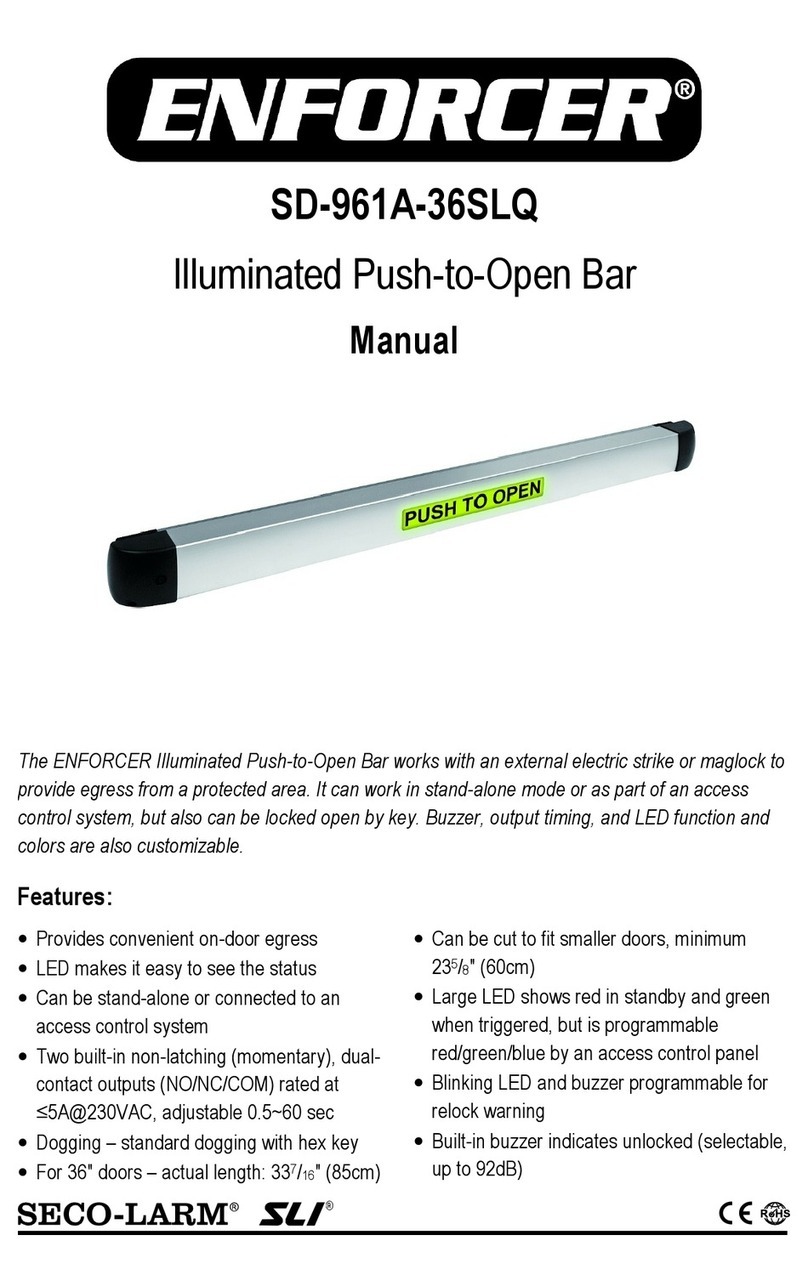
ENFORCER
ENFORCER SECO-LARM SD-961A-36SLQ manual

Wayne-Dalton
Wayne-Dalton Torquemaster Plus installation instructions
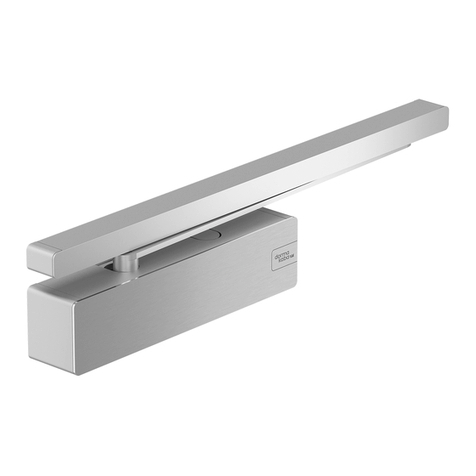
Dormakaba
Dormakaba TS 98 XEA Mounting instructions
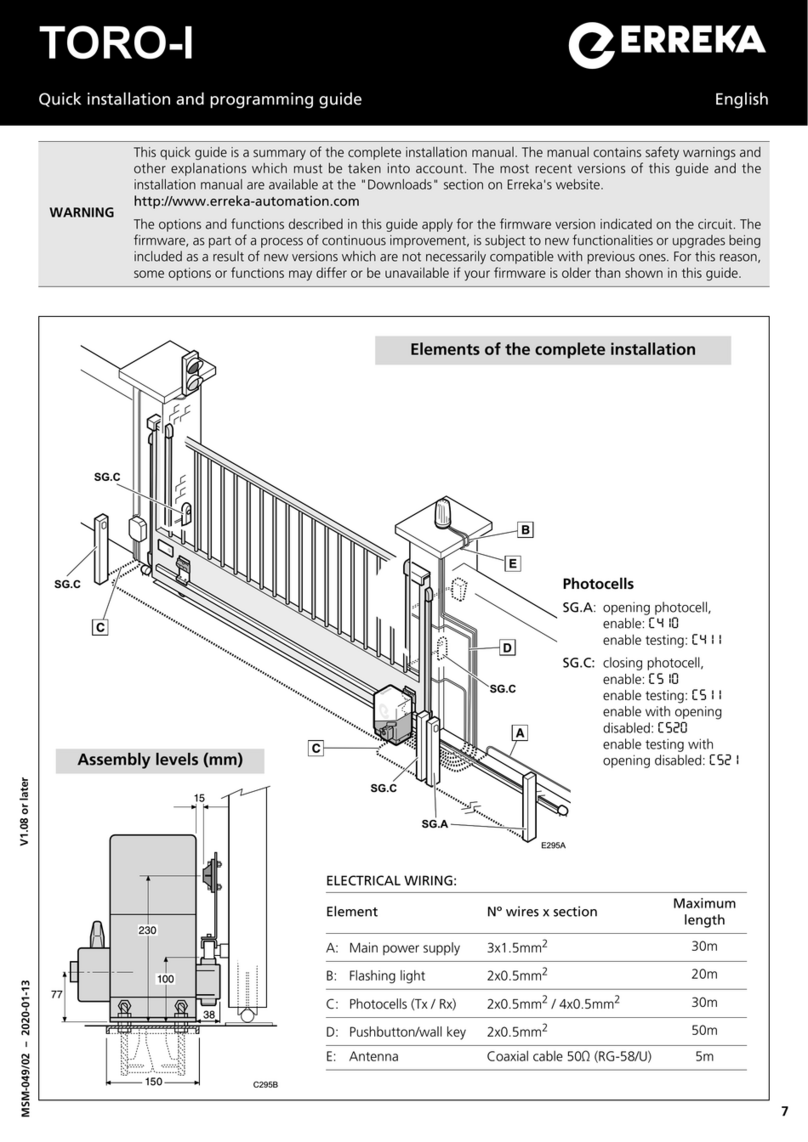
Gerreka
Gerreka TORO-I Quick installation and programming guide
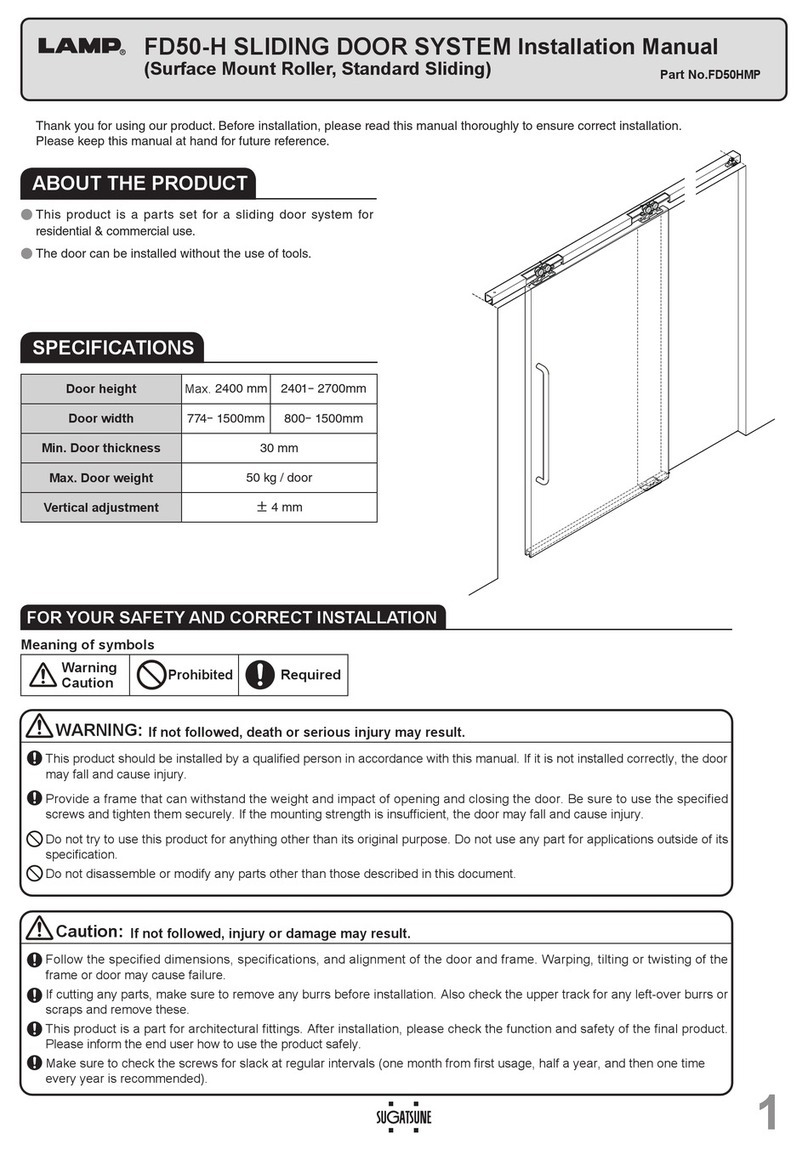
SUGATSUNE
SUGATSUNE LAMP FD50-H installation manual

Visionis
Visionis VIS-8009 user manual
